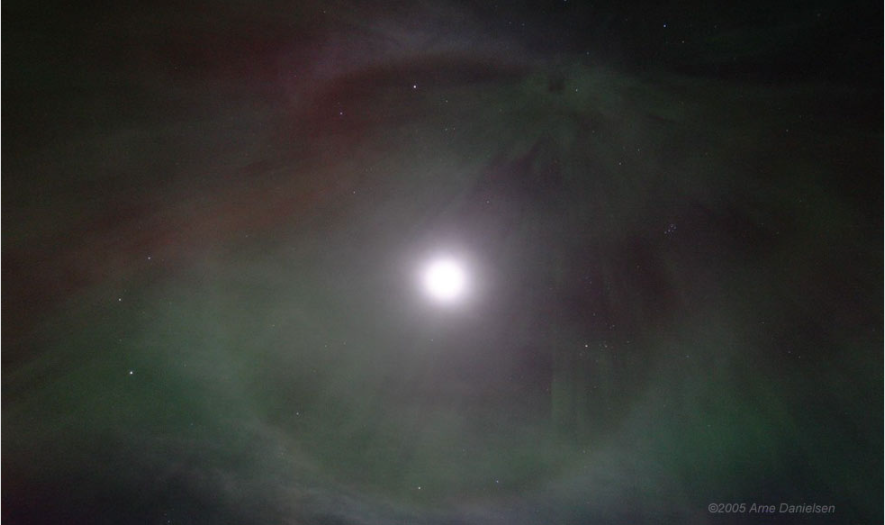Lunar Halo & Aurora Norway
Lunar Halo & Aurora Norway: A Mesmerizing Celestial Display
When it comes to atmospheric optics, few phenomena capture the imagination quite like the combination of a lunar halo and an aurora. These celestial spectacles, which occur independently but occasionally coincide, can create a truly awe-inspiring sight in the night sky. In this article, we delve into the intricacies of lunar halos and auroras, focusing on a captivating image captured in Norway by Arne Danielsen during a remarkable auroral display over Europe on January 21st, 2005.
The image showcases the moon high in the sky, surrounded by a radiant lunar halo. A lunar halo occurs when the light from the moon is refracted and reflected by ice crystals present in the Earth's atmosphere. These ice crystals, typically found in thin cirrus clouds, act as miniature prisms, bending the moonlight and creating a ring of light around the moon. The halo in the image appears to be a 22-degree halo, which is commonly observed and caused by poorly oriented ice crystals.
However, upon closer inspection, it is possible that the halo in this image is a circumscribed halo rather than a 22-degree halo. Circumscribed halos are produced by horizontal columns of ice crystals and are characterized by sharper edges and brighter colors compared to 22-degree halos. They are also often accompanied by a parhelic circle, an additional optical phenomenon caused by sunlight passing through ice crystals.
The coincidence of a lunar halo and an aurora in the same image adds an extra layer of enchantment to this already mesmerizing scene. Auroras, also known as the Northern or Southern Lights depending on their location, are natural light displays that occur in the polar regions. They are caused by charged particles from the sun colliding with atoms and molecules in the Earth's atmosphere, resulting in the emission of colorful light.
In this particular image, the glowing atoms of the aurora are situated above the ice crystals that form the lunar halo. The combination of these two celestial phenomena creates a captivating contrast between the ethereal glow of the aurora and the delicate ring of light surrounding the moon. It serves as a reminder of the intricate interactions between various atmospheric elements that contribute to the beauty of our planet.
The presence of additional celestial objects in the image further enhances its allure. To the right of the moon, we can see the Pleiades and Taurus, two prominent star clusters and constellations. To the left of the moon, Castor and Pollux, the twin stars of the Gemini constellation, make their appearance. Finally, in the lower left corner, Saturn, the sixth planet from the sun, adds its celestial presence to this already enchanting tableau.
Capturing such a stunning image requires both skill and luck. Arne Danielsen's astrophotography expertise allowed him to immortalize this captivating moment in time. The image serves as a testament to the power of nature's artistic palette and reminds us of the boundless wonders that await us in the night sky.
In conclusion, the combination of a lunar halo and an aurora creates a truly awe-inspiring celestial display. The image captured in Norway by Arne Danielsen showcases this captivating phenomenon in all its glory. From the radiant lunar halo to the vibrant colors of the aurora, every element in this image contributes to its mesmerizing beauty. It serves as a reminder of the intricate interplay between atmospheric optics, celestial bodies, and natural phenomena, reminding us of the wonders that lie beyond our terrestrial realm.

Lunar halo and aurora. Imaged in Norway by Arne Danielsen (astrophotography and atmospheric phenomena) during the great auroral display over Europe on 21st January 2005. The ice crystals of the thin cirrus layer that created the halo are well below the glowing atoms of the aurora. The Pleiades and Taurus are to the right of the moon, Castor and Pollux to the left and Saturn lower left.
The moon was high in the sky when this image was taken. Whenever the sun or moon is high and a circular halo is seen, it could be a circumscribed halo produced by horizontal columns rather than a 22º halo made by poorly oriented crystals. The two are not easy to distinguish but the circumscribed halo is slightly sharper with brighter colours -- it is usually also accompanied by a parhelic circle. This one looks like a 22º halo.
Note: this article has been automatically converted from the old site and may not appear as intended. You can find the original article here.
Reference Atmospheric Optics
If you use any of the definitions, information, or data presented on Atmospheric Optics, please copy the link or reference below to properly credit us as the reference source. Thank you!
-
<a href="https://atoptics.co.uk/blog/lunar-halo-aurora-norway/">Lunar Halo & Aurora Norway</a>
-
"Lunar Halo & Aurora Norway". Atmospheric Optics. Accessed on April 16, 2024. https://atoptics.co.uk/blog/lunar-halo-aurora-norway/.
-
"Lunar Halo & Aurora Norway". Atmospheric Optics, https://atoptics.co.uk/blog/lunar-halo-aurora-norway/. Accessed 16 April, 2024
-
Lunar Halo & Aurora Norway. Atmospheric Optics. Retrieved from https://atoptics.co.uk/blog/lunar-halo-aurora-norway/.